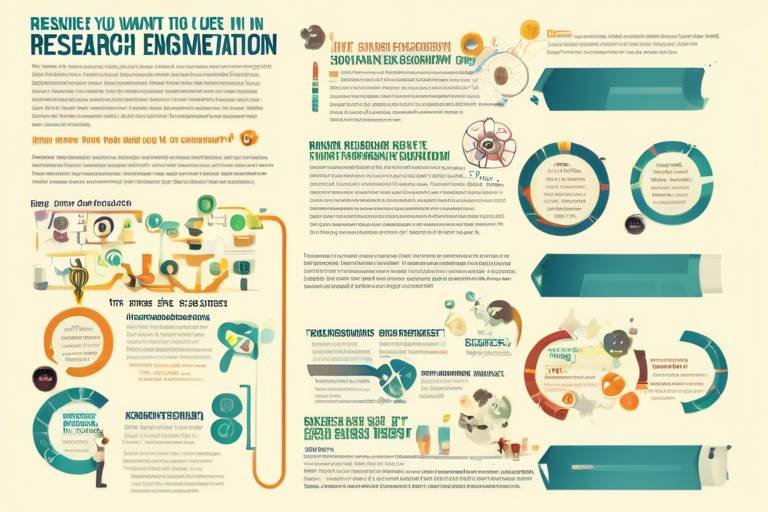Innovations in Community Health Research Methods
In the ever-evolving landscape of healthcare, community health research has emerged as a vital component for understanding and addressing the unique health needs of diverse populations. As we navigate through the complexities of public health, innovative research methodologies are paving the way for more effective and inclusive health interventions. These advancements not only enhance the quality of data collected but also foster deeper engagement with community members, ensuring that their voices are heard and valued in the research process.
Today, we find ourselves at the intersection of technology and community engagement, where traditional research methods are being reimagined through innovative approaches. From participatory research to the integration of digital health technologies, the landscape is rich with opportunities to improve health outcomes. The goal is not just to collect data but to create a collaborative environment where community members become active participants in shaping their health narratives.
One of the most exciting developments in this field is the rise of participatory research approaches. These methods invite community members to play an integral role in the research process, ensuring that their insights and experiences directly influence health interventions. Imagine a research study where the participants are not just subjects but co-researchers, helping to design the study, collect data, and interpret findings. This level of involvement not only enhances the relevance of the research but also builds trust and ownership within the community.
However, implementing participatory methods comes with its own set of challenges. Balancing the power dynamics between researchers and community members requires careful consideration and a commitment to genuine collaboration. Researchers must be willing to listen, adapt, and sometimes step back to allow community voices to take center stage. This shift in perspective can be daunting but ultimately leads to more impactful and sustainable health solutions.
As we dive deeper into the realm of community health research, the integration of digital health technologies has revolutionized how we collect and analyze data. These tools, ranging from mobile health applications to telehealth services, have not only streamlined the research process but also expanded our reach to underserved populations. With the click of a button, researchers can gather real-time data, monitor patient progress, and engage with communities in ways that were previously unimaginable.
Mobile health applications, for instance, have become a game-changer in community health research. They enable researchers to collect data in real-time and provide participants with instant access to health information, resources, and support. This level of accessibility is particularly crucial for marginalized populations who may face barriers to traditional healthcare services. By harnessing the power of mobile technology, researchers can ensure that health interventions are tailored to the specific needs of these communities.
Moreover, wearable health devices are making waves in the research world by offering continuous health data collection. These gadgets can track everything from heart rates to physical activity levels, providing researchers with invaluable insights into community health trends. Imagine having a comprehensive view of how lifestyle factors affect health outcomes in real-time. This data not only informs research but also empowers individuals to take charge of their health.
Telehealth services have also played a pivotal role in expanding access to healthcare and research participation. By breaking down geographical barriers, telehealth allows researchers to connect with participants in remote or underserved areas, ensuring that no one is left behind. This shift towards virtual engagement has not only increased participation rates but also enriched the diversity of research samples, leading to more comprehensive findings.
As we embrace these innovations, it’s essential to remember that advanced data analytics and visualization techniques are equally crucial for interpreting complex health data. With the right tools, researchers can transform raw data into meaningful insights, helping to identify patterns and trends that inform public health strategies. These visualization techniques allow for clearer communication of findings, making it easier for stakeholders to understand and act upon the data.
In conclusion, the innovations in community health research methods are not just about technology; they are about fostering collaboration, enhancing engagement, and ultimately improving health outcomes for all. As we continue to explore these advancements, the focus must remain on building trust, ensuring ethical practices, and empowering communities to take an active role in their health journeys.
- What is community health research? Community health research focuses on understanding the health needs and challenges faced by specific communities, often involving community members in the research process to ensure relevance and effectiveness.
- How do participatory research approaches work? Participatory research approaches actively involve community members in the research process, allowing them to contribute to study design, data collection, and interpretation of results.
- What role do digital health technologies play in research? Digital health technologies, such as mobile apps and telehealth services, facilitate real-time data collection and improve access to health information, particularly for underserved populations.
- Why are wearable devices important in community health research? Wearable devices provide continuous health data, offering researchers valuable insights into health trends and enhancing participant engagement.
- What are the ethical considerations in community health research? Ethical considerations include ensuring respect and equity in community engagement, safeguarding participant privacy, and navigating power dynamics between researchers and community members.

Participatory Research Approaches
Participatory research approaches are revolutionizing the way we conduct community health research. Imagine a scenario where community members are not just passive subjects but active contributors to the research process. This shift is not only refreshing but also essential for creating health interventions that truly resonate with the needs of the population. By involving community members, researchers can gather invaluable insights that shape the direction of health initiatives, making them more effective and culturally relevant.
One of the most compelling benefits of participatory research is the enhancement of trust between researchers and the community. When individuals see that their voices are heard and valued, they are more likely to engage in the research process. This trust can lead to increased participation rates, which is crucial for obtaining diverse and comprehensive data. However, implementing these participatory methods does come with its own set of challenges. Researchers must navigate the complexities of community dynamics, ensuring that all voices are represented and that power imbalances do not skew the research outcomes.
To illustrate the benefits and challenges of participatory research, let’s consider some key aspects:
| Benefits | Challenges |
|---|---|
| Enhanced community trust and engagement | Potential for conflicting interests among community members |
| More relevant and culturally sensitive health interventions | Time-consuming process requiring extensive communication |
| Increased data richness and diversity | Need for researchers to adapt to community needs and feedback |
Furthermore, participatory research fosters a sense of ownership within the community. When individuals feel that they have a stake in the research, they are more likely to support and advocate for the findings. This ownership can lead to sustainable health practices that extend beyond the research period. However, it is crucial for researchers to approach this process with humility and openness, recognizing that community members are the experts in their own lives.
In conclusion, participatory research approaches are not just a trend; they represent a fundamental shift in how we think about community health research. By actively involving community members, we can create more effective, relevant, and sustainable health interventions. The journey may be fraught with challenges, but the rewards—improved health outcomes and empowered communities—are well worth the effort. Are you ready to embrace this innovative approach and transform the landscape of community health research?

Digital Health Technologies
In recent years, the landscape of community health research has been dramatically reshaped by the advent of . These innovations have not only streamlined the processes of data collection and analysis but have also significantly improved patient engagement. Imagine a world where health data can be gathered in real-time, where patients can actively participate in their health journey, and where researchers can reach populations that were once difficult to engage. This is the promise of digital health technologies, and it’s becoming a reality.
One of the most exciting aspects of digital health technologies is their ability to transcend geographical barriers. Traditional methods of data collection often required in-person visits, which could limit participation from individuals in remote or underserved areas. However, with the integration of digital tools, researchers can now reach a broader audience. For instance, online surveys and mobile applications allow participants to share their health information from the comfort of their homes, making it easier for everyone to contribute to vital health research.
Moreover, the use of mobile health applications has revolutionized how we gather data. These apps are designed not just for health tracking but also for fostering community engagement. They can send reminders for medication, provide tailored health tips, and even facilitate virtual support groups. By integrating these functionalities, mobile health apps serve as a bridge between healthcare providers and patients, ensuring that health information is readily accessible. This is particularly beneficial for those who may not have regular access to healthcare services.
Mobile health applications are like having a personal health assistant in your pocket. They can collect real-time data on various health metrics, such as physical activity, dietary habits, and even mental well-being. This data can then be analyzed to identify trends and patterns within specific communities. For example, if a significant number of users report high stress levels, researchers can investigate potential community-wide stressors and develop targeted interventions.
Another fascinating element of digital health technologies is the rise of wearable health devices. These gadgets, ranging from smartwatches to fitness trackers, continuously monitor health indicators such as heart rate, sleep patterns, and physical activity levels. The data collected from these devices can provide researchers with invaluable insights into community health trends. Imagine a researcher analyzing data from thousands of wearables to understand how lifestyle factors affect health outcomes in different populations. This kind of data can lead to more effective public health strategies and personalized health interventions.
Lastly, let’s talk about telehealth services. Telehealth has emerged as a game-changer in expanding access to healthcare and research participation. It allows individuals to consult healthcare professionals via video calls, phone calls, or messaging platforms, eliminating the need for travel. This is particularly significant for marginalized populations who may face barriers to accessing traditional healthcare services. By utilizing telehealth, researchers can engage with these populations more effectively, ensuring that their voices are heard and their health needs are addressed.
In summary, the integration of digital health technologies into community health research is not just a trend; it’s a transformative movement. These tools enhance data collection, foster engagement, and ultimately lead to improved health outcomes. As we continue to embrace these innovations, it’s essential to remain mindful of the ethical implications and to ensure that all community members have equal access to these digital resources.
- What are digital health technologies?
Digital health technologies refer to tools and platforms that utilize digital resources to enhance health care delivery and research, including mobile apps, telehealth services, and wearable devices. - How do mobile health applications improve community health research?
Mobile health applications facilitate real-time data collection, enhance patient engagement, and expand access to health information, especially for underserved populations. - What role do wearable devices play in health research?
Wearable devices continuously collect health data, providing researchers with insights into health trends and patterns within communities. - Why are telehealth services important in community health research?
Telehealth services increase accessibility for marginalized populations, allowing researchers to engage with individuals who might otherwise be excluded from traditional research methods.

Mobile Health Applications
In recent years, have emerged as a game-changer in community health research, revolutionizing the way data is collected and health information is disseminated. Imagine having a personal health assistant right in your pocket, ready to track your fitness, remind you to take your medication, or even connect you with healthcare professionals at the touch of a button. These applications not only facilitate real-time data collection but also empower users to engage actively in their health journeys. With the ability to gather data directly from individuals, researchers can obtain a wealth of information that was previously difficult to access, particularly from underserved populations.
One of the most exciting aspects of mobile health applications is their capacity to enhance access to health information. For instance, users can receive tailored health tips based on their specific needs, participate in health challenges, or even access educational resources that help them make informed decisions. This level of engagement can be particularly impactful in communities where traditional healthcare resources are limited or where individuals may feel disconnected from conventional health services.
Moreover, mobile health applications often incorporate features that encourage user interaction and community building. For example, many apps include forums or social features that allow users to share their experiences and support one another. This sense of community can significantly enhance motivation and adherence to health interventions. As a result, mobile health applications are not just tools for data collection; they are platforms for community engagement and empowerment.
However, it’s essential to acknowledge the challenges that come with implementing mobile health applications in community health research. Issues such as digital literacy and access to technology can create barriers for some populations. Researchers must be mindful of these challenges and work collaboratively with communities to ensure that mobile health solutions are accessible and beneficial for everyone. This might involve providing training sessions on how to use the apps or ensuring that the technology is user-friendly and available on various devices.
In conclusion, mobile health applications represent a promising avenue for enhancing community health research. By bridging the gap between researchers and participants, these tools not only facilitate data collection but also foster a sense of community and engagement that is vital for improving health outcomes. As technology continues to evolve, the potential for mobile health applications to transform community health research is boundless, paving the way for more inclusive and effective health interventions.
- What are mobile health applications? Mobile health applications are software programs designed to run on smartphones and tablets, allowing users to monitor their health, access health information, and communicate with healthcare providers.
- How do mobile health applications improve community health research? They facilitate real-time data collection, enhance patient engagement, and provide access to health information, especially for underserved populations.
- Are there challenges associated with mobile health applications? Yes, challenges include digital literacy, access to technology, and ensuring the applications are user-friendly for all populations.
- Can mobile health applications foster community engagement? Absolutely! Many apps include social features that allow users to connect, share experiences, and support each other, enhancing motivation and adherence to health interventions.

Wearable Health Devices
Wearable health devices have taken the healthcare landscape by storm, acting as a bridge between technology and personal health management. These devices, which range from smartwatches to fitness trackers, continuously collect data on various health metrics, providing invaluable insights into individual and community health trends. Imagine having a personal health assistant strapped to your wrist, monitoring your heart rate, sleep patterns, and even stress levels in real-time! This level of continuous monitoring not only empowers individuals to take charge of their health but also offers researchers a treasure trove of data to analyze.
One of the most significant advantages of wearable health devices is their ability to gather data from a diverse range of users, often in real-time. This capability is particularly beneficial for community health research, as it allows researchers to track health trends across different demographics and geographic locations. For instance, by analyzing data collected from wearables, researchers can identify patterns related to physical activity, chronic diseases, and even mental health indicators within specific communities. This data-driven approach enables targeted health interventions that are more likely to resonate with the populations they aim to serve.
However, the implementation of wearable health devices in research is not without challenges. Issues such as data privacy, user compliance, and the digital divide can pose significant hurdles. Many individuals may be hesitant to share their health data due to privacy concerns, while others may lack access to the technology altogether. To address these challenges, researchers must prioritize ethical considerations and ensure that the benefits of wearable technology are accessible to all, particularly underserved populations.
Moreover, the implications of wearable health devices extend beyond data collection. They also enhance participant engagement in research. For instance, many wearable devices come equipped with features that encourage users to set health goals and track their progress. This gamification aspect can motivate individuals to participate actively in research studies, leading to richer data and improved health outcomes. As participants become more engaged, researchers can foster a collaborative environment where community members feel valued and heard.
In summary, wearable health devices are revolutionizing the way community health research is conducted. By providing real-time data and enhancing participant engagement, these devices not only improve our understanding of health trends but also empower individuals to take charge of their health. As we continue to explore the potential of wearable technology, it is essential to address the accompanying challenges to ensure equitable access and ethical use. The future of community health research is undoubtedly intertwined with the advancements in wearable health technology, making it an exciting frontier for researchers and communities alike.
- What are wearable health devices?
Wearable health devices are gadgets like smartwatches and fitness trackers that monitor various health metrics, such as heart rate, sleep quality, and physical activity. - How do wearable devices benefit community health research?
They provide continuous, real-time data that helps researchers identify health trends and tailor interventions for specific populations. - Are there any privacy concerns with wearable health devices?
Yes, users may be hesitant to share their health data due to privacy issues, making it crucial for researchers to prioritize ethical considerations. - Can wearable devices improve participant engagement in research?
Absolutely! Many wearables include features that encourage goal-setting and tracking, which can motivate users to actively participate in research studies.

Telehealth Services
In recent years, have emerged as a groundbreaking solution to expand access to healthcare, particularly in community health research. Imagine being able to consult a healthcare professional without the hassle of travel or long wait times—this is the reality that telehealth offers. By leveraging technology, telehealth bridges geographical gaps, allowing researchers to reach remote or marginalized populations who might otherwise lack access to essential health services.
One of the most significant advantages of telehealth is its ability to facilitate real-time communication between healthcare providers and patients. This immediacy not only enhances patient engagement but also allows researchers to gather timely data on health trends and outcomes. For instance, during a public health crisis, such as the COVID-19 pandemic, telehealth became a lifeline for many, enabling continuous care while minimizing the risk of virus transmission. The flexibility of telehealth services means that patients can receive care from the comfort of their homes, which is particularly beneficial for those with mobility issues or those living in rural areas.
Furthermore, telehealth services can be tailored to meet the specific needs of diverse populations. Researchers can design interventions that are culturally relevant and accessible, ensuring that health information is not only disseminated but also understood. This approach fosters a sense of community involvement and ownership over health outcomes, which is crucial for the success of any health initiative. For example, community health workers can use telehealth platforms to provide education and support, guiding patients through their health journeys and encouraging them to participate in research studies.
However, the implementation of telehealth services is not without its challenges. Issues such as internet access and technological literacy can create barriers for some individuals. To address these challenges, researchers must consider strategies to improve digital literacy and provide necessary resources, ensuring that all community members can benefit from telehealth services. Additionally, ethical considerations regarding patient privacy and data security must be prioritized to maintain trust and integrity in community health research.
In summary, telehealth services represent a significant advancement in community health research methodologies. By enhancing accessibility and engagement, these services not only improve health outcomes but also empower communities to take an active role in their health. As we continue to explore the potential of telehealth, it is essential to address the challenges and ensure that all voices are heard in the research process.
- What is telehealth? Telehealth refers to the use of digital information and communication technologies to access healthcare services remotely.
- How does telehealth improve community health research? Telehealth enhances accessibility, enables real-time data collection, and fosters patient engagement, particularly among underserved populations.
- What challenges are associated with telehealth services? Challenges include internet access, technological literacy, and concerns about patient privacy and data security.
- Can telehealth services be culturally tailored? Yes, telehealth services can be designed to meet the specific cultural needs of diverse populations, ensuring relevance and understanding.

Data Analytics and Visualization
In the fast-paced world of community health research, data analytics and visualization play a pivotal role in transforming raw data into actionable insights. Imagine trying to navigate a dense forest without a map—this is akin to analyzing health data without proper tools. Advanced analytics allow researchers to uncover patterns, trends, and correlations that might otherwise remain hidden. By employing sophisticated statistical methods and algorithms, researchers can delve deeper into community health issues, identifying not just what is happening, but also why it is happening.
One of the most significant advancements in this area is the use of visualization techniques. These techniques help to present complex data in a more digestible format, making it easier for stakeholders—including community members, policymakers, and health practitioners—to understand the implications of the findings. For instance, interactive dashboards can showcase health metrics in real-time, allowing users to explore data from different angles. This not only enhances engagement but also fosters a sense of ownership among community members regarding their health outcomes.
Furthermore, the integration of geospatial analysis into health research has revolutionized our understanding of health disparities. By mapping health data geographically, researchers can visualize how social determinants such as income, education, and access to healthcare influence health outcomes. This spatial perspective is crucial for identifying areas that require targeted interventions. For example, a heat map highlighting areas with high rates of diabetes can help direct resources and initiatives to those neighborhoods most in need.
To illustrate the impact of data analytics and visualization in community health research, consider the following table:
| Analytics Technique | Purpose | Example Application |
|---|---|---|
| Descriptive Analytics | Summarizes historical data to understand trends | Analyzing past health survey results |
| Predictive Analytics | Forecasts future trends based on historical data | Predicting outbreaks of infectious diseases |
| Prescriptive Analytics | Recommends actions based on data analysis | Suggesting intervention strategies for high-risk populations |
These analytics techniques not only enhance our understanding of community health issues but also empower communities to take action. When data is presented clearly and compellingly, it can spark conversations and drive initiatives that lead to improved health outcomes. Moreover, engaging community members in the data interpretation process fosters a collaborative environment where their voices matter.
In conclusion, as we continue to embrace innovative data analytics and visualization methods, we are better equipped to tackle the complex challenges facing community health today. The combination of advanced analytical tools and effective visual communication creates a powerful synergy that can lead to more informed decisions, targeted interventions, and ultimately, healthier communities.
- What is the role of data analytics in community health research? Data analytics helps researchers identify trends and correlations in health data, enabling them to make informed decisions and develop targeted interventions.
- How does visualization enhance understanding of health data? Visualization techniques present complex data in a more accessible format, making it easier for stakeholders to grasp key insights and implications.
- What are some examples of digital tools used in data analytics? Tools like Tableau, R, and Python are commonly used for data analysis and visualization in community health research.
- Why is community engagement important in health research? Engaging community members fosters trust, ensures that research is relevant to their needs, and empowers them to take an active role in their health.

Community-Based Participatory Research (CBPR)
Community-Based Participatory Research, or CBPR, is a transformative approach that redefines traditional research methodologies by placing community members at the heart of the research process. This collaborative framework not only empowers communities but also ensures that the research is relevant and beneficial to the populations involved. By actively engaging community members, CBPR fosters a sense of ownership and trust, which is crucial for effective health interventions. Imagine a scenario where researchers and community members sit together, sharing ideas and insights, much like a potluck dinner where everyone brings their unique dish to the table. This collective effort enriches the research process and enhances the outcomes.
One of the primary principles of CBPR is the emphasis on collaboration. Researchers work alongside community members to identify health issues that matter most to them. This partnership allows for a deeper understanding of the social, cultural, and economic factors that influence health in specific communities. As a result, the interventions developed are more likely to resonate with the community and lead to sustainable change. However, implementing CBPR is not without its challenges. It requires a shift in mindset from viewing communities merely as subjects of study to recognizing them as equal partners in the research journey.
Moreover, CBPR plays a pivotal role in addressing health disparities. By focusing on marginalized and underserved populations, this approach helps to highlight the unique barriers these groups face in accessing healthcare. For instance, a recent study in a low-income neighborhood revealed that transportation issues were a significant barrier to accessing health services. Through CBPR, community members were able to voice these concerns, leading to the development of a community shuttle service that improved access to healthcare facilities. This example illustrates how CBPR not only identifies problems but also mobilizes resources to find practical solutions.
To further illustrate the impact of CBPR, consider the following table that outlines key components and benefits of this approach:
| Component | Benefit |
|---|---|
| Community Engagement | Increases trust and collaboration between researchers and community members. |
| Shared Decision-Making | Ensures that the research addresses the actual needs and priorities of the community. |
| Capacity Building | Empowers community members through training and resources, fostering long-term sustainability. |
| Equity Focus | Addresses health disparities by prioritizing the needs of marginalized populations. |
While CBPR has numerous advantages, it also requires careful consideration of ethical issues. Researchers must navigate the complexities of informed consent, confidentiality, and the potential for exploitation. Establishing clear ethical guidelines is essential to ensure that community members feel respected and valued throughout the research process. This ethical framework not only protects participants but also enhances the credibility of the research itself.
In conclusion, Community-Based Participatory Research is more than just a methodology; it is a philosophy that champions collaboration, empowerment, and equity. By integrating the voices of community members into the research process, CBPR paves the way for health interventions that are not only effective but also culturally relevant and sustainable. As we continue to explore innovative research methods, embracing CBPR will undoubtedly lead to improved health outcomes and stronger communities.
- What is the main goal of CBPR? The primary goal of CBPR is to engage community members as equal partners in the research process to address health issues that matter to them.
- How does CBPR differ from traditional research methods? Unlike traditional research, which often views communities as subjects, CBPR emphasizes collaboration and shared decision-making.
- What are some challenges of implementing CBPR? Challenges include building trust, ensuring ethical practices, and managing differing expectations between researchers and community members.
- How can communities benefit from CBPR? Communities can benefit through increased access to resources, empowerment, and interventions tailored to their specific needs.

Building Community Capacity
Building community capacity is not just a buzzword; it's a fundamental element of effective community health research. When we talk about empowering communities, we refer to equipping them with the skills, knowledge, and resources necessary to actively participate in health initiatives. Imagine a community as a garden—without the right nutrients, sunlight, and care, it cannot flourish. Similarly, communities need support and resources to thrive in health research. This support can come in various forms, including training programs, access to information, and funding opportunities.
One of the primary strategies for building capacity is through education and training. By providing community members with workshops and training sessions, researchers can help them understand the research process, the importance of data collection, and how to analyze results. This not only enhances their skills but also boosts their confidence to engage in research activities. For instance, training sessions can cover topics like:
- Understanding health data and its implications
- Research methodologies and ethical considerations
- Effective communication strategies with researchers
Additionally, creating partnerships with local organizations can significantly enhance community capacity. These organizations often have established trust and relationships within the community, making it easier to mobilize resources and engage participants. Collaborating with local leaders can also ensure that the research is culturally relevant and addresses the specific needs of the community.
Moreover, providing access to resources is crucial. Communities often face barriers such as lack of funding, limited access to technology, and insufficient infrastructure. By addressing these challenges, researchers can create an environment conducive to active participation. For example, establishing community health centers equipped with the necessary tools for research can facilitate better engagement. Think of it as setting up a library in a neighborhood—once people have access to books and resources, their thirst for knowledge and participation grows.
Lastly, it’s essential to foster a sense of ownership among community members. When individuals feel that they have a stake in the research, they are more likely to contribute meaningfully. This can be achieved by involving them in the decision-making process and ensuring that their voices are heard. When communities see the benefits of their involvement, it creates a ripple effect, encouraging more people to participate and support health initiatives.
In conclusion, building community capacity is a multifaceted approach that requires commitment, resources, and collaboration. By investing in education, partnerships, and access to resources, researchers can empower communities to take an active role in health research, ultimately leading to more effective and relevant health interventions.
Q1: What is community capacity building?
A1: Community capacity building refers to the process of equipping communities with the skills, resources, and knowledge necessary to actively participate in health initiatives and research.
Q2: Why is community engagement important in health research?
A2: Community engagement ensures that research is relevant and culturally appropriate, leading to better health outcomes and increased trust between researchers and community members.
Q3: How can communities be empowered to participate in health research?
A3: Communities can be empowered through education, training, access to resources, and by fostering a sense of ownership in the research process.

Ethical Considerations in CBPR
When it comes to Community-Based Participatory Research (CBPR), ethical considerations are paramount. Engaging communities in research isn't just about gathering data; it's about building trust and ensuring that the voices of those most affected by health disparities are heard and respected. This participatory approach requires researchers to navigate a complex landscape of ethical challenges, ensuring that they uphold the principles of respect, equity, and mutual benefit.
One of the primary ethical concerns in CBPR is the issue of informed consent. It's essential that community members fully understand the research process, including its potential risks and benefits. This goes beyond simply providing a consent form; it involves ongoing communication and education, allowing participants to ask questions and express concerns. Researchers must ensure that consent is not just a one-time event but a continuous dialogue throughout the study.
Moreover, the concept of reciprocity plays a critical role in ethical CBPR. Researchers must consider what benefits the community will gain from their involvement. This could be in the form of health interventions, access to resources, or even training opportunities. If the community feels that they are merely subjects of research, rather than partners, it can lead to mistrust and disengagement. Therefore, establishing a clear framework for reciprocity is vital for maintaining a positive relationship between researchers and participants.
Another ethical consideration is the representation of diverse voices within the community. CBPR aims to include various demographics, ensuring that marginalized groups are not overlooked. However, this can be challenging, as power dynamics often exist within communities. Researchers must be aware of these dynamics and strive to create an inclusive environment where all voices are valued. This might involve actively seeking out underrepresented populations and ensuring their perspectives are integrated into the research process.
To help navigate these ethical considerations, researchers can follow a set of guiding principles:
- Transparency: Maintain open communication about the research goals, processes, and potential impacts.
- Equity: Ensure that all community members have equal opportunities to participate and benefit from the research.
- Respect: Honor the cultural values and practices of the community throughout the research process.
- Accountability: Be accountable to the community by sharing findings and outcomes in an accessible manner.
In conclusion, ethical considerations in CBPR are not merely an afterthought; they are integral to the success and integrity of the research. By prioritizing informed consent, reciprocity, representation, and adhering to guiding principles, researchers can foster an environment of trust and collaboration. This not only enhances the quality of the research but also contributes to meaningful health improvements in the community.
Q1: What is the primary goal of CBPR?
A1: The primary goal of CBPR is to engage community members as active participants in the research process, ensuring that their insights and experiences shape health interventions and outcomes.
Q2: How can researchers ensure ethical practices in CBPR?
A2: Researchers can ensure ethical practices by prioritizing informed consent, maintaining transparency, fostering reciprocity, and being accountable to the community throughout the research process.
Q3: Why is representation important in CBPR?
A3: Representation is crucial in CBPR to ensure that diverse voices, especially from marginalized groups, are included in the research, leading to more comprehensive and relevant health interventions.
Frequently Asked Questions
- What is participatory research in community health?
Participatory research is a collaborative approach where community members actively engage in the research process. This method ensures that their insights and experiences shape the health interventions being studied, leading to more relevant and effective outcomes.
- How do digital health technologies enhance community health research?
Digital health technologies, such as mobile apps and telehealth services, streamline data collection and improve patient engagement. They allow researchers to reach a broader audience, especially underserved populations, and facilitate real-time data monitoring and feedback.
- What are mobile health applications and their benefits?
Mobile health applications are tools that enable users to track their health data and receive health information directly on their smartphones. These apps facilitate community health research by providing researchers with immediate access to health metrics, thereby improving the quality and speed of data collection.
- How do wearable health devices contribute to community health research?
Wearable health devices continuously collect health data, such as heart rate and activity levels, which can reveal important trends in community health. This technology not only enhances participant engagement but also provides researchers with rich datasets to analyze health behaviors over time.
- What role does telehealth play in community health research?
Telehealth expands access to healthcare and research participation, particularly for remote or marginalized populations. By using telehealth services, researchers can conduct interviews, gather data, and provide health interventions, all while overcoming geographical barriers.
- What are the key principles of Community-Based Participatory Research (CBPR)?
CBPR emphasizes collaboration between researchers and community members, ensuring that the research is relevant and beneficial to the community. Key principles include mutual respect, shared decision-making, and a focus on addressing health disparities through collective action.
- How can communities build capacity to participate in health research?
Building community capacity involves providing training, resources, and support to empower community members to engage actively in health research initiatives. This could include workshops, mentorship programs, and access to research tools that enhance their skills and knowledge.
- What ethical considerations are important in CBPR?
Ethical considerations in CBPR include ensuring informed consent, maintaining respect for community values, and promoting equity in research practices. Researchers must navigate these challenges carefully to foster trust and ensure that community members' rights and voices are prioritized throughout the research process.


















